17 September 2024 : Daily Current Affairs
1. ‘Renewable energy sector will power India’s growth’
- 1. ‘Renewable energy sector will power India’s growth’
- 2. How quantum computing can make large language models even better
- 3. How do emergency provisions impact Centre-State relations?
- 4. What is the current status of the introduction of African cheetahs?
- 5. India Strongly Rejects Iran’s Supreme Leader’s Remarks on Muslim Suffering, Calls Comments “Misinformed”
- PRELIMS FACTS
- 1. Rising Threat of Antimicrobial Resistance: A Major Challenge in India’s Fight Against Infections
- 2. Pregnancy Reshapes the Brain: Study Reveals Significant Changes in Grey and White Matter
- 3. Government Plans ₹6,000 Crore Boost for Precision Farming with AI, Drones, and IoT Integration
- 4. Union Finance Minister Smt. Nirmala Sitharaman to launch NPS Vatsalya Scheme on September 18, 2024
- 5. After peace talks, Dalits get entry to temple in Tamil Nadu
- 6. Stone-eaters that threaten Iran’s ancient Persepolis
(Source – The Hindu, International Edition – Page No. – 4)
| Topic: GS3 – Indian Economy – Infrastructure – Energy |
| Context |
|

Analysis of the news:
Steps taken by the Indian government to advance renewable energy and infrastructure development:
- Expansion of Infrastructure: Announced the creation of 12 new industrial cities and eight high-speed road corridors to boost economic growth.
- Railway Upgrades: Launched over 15 semi-high-speed Vande Bharat trains to enhance connectivity.
- Research Funding: Established a ₹1 trillion fund to promote research and development in various sectors.
- E-Mobility Promotion: Initiated various measures to drive the adoption of electric mobility.
- Biomanufacturing: Introduced the Bio-E3 policy to advance high-performance biomanufacturing.
- Offshore Wind Energy: Launched a viability gap funding scheme worth over ₹7,000 crore to support offshore wind projects.
- Renewable Energy Targets: Set a goal to achieve 500 GW of renewable energy by 2030.
- Climate Commitments: Achieved Paris climate goals nine years ahead of schedule.
These initiatives aim to reinforce India’s position as a leader in renewable energy and sustainable development.
| PYQ: India has immense potential of solar energy though there are regional variaSons in its development. Elaborate. (250 words/15m) (UPSC CSE (M) GS-1 2020) |
| Practice Question: Discuss the role of renewable energy in India’s quest for sustainable development and economic growth. What steps has the government taken to meet its energy requirements, and how can these initiatives help India achieve its climate commitments while becoming a developed nation by 2047? (250 Words /15 marks) |
2. How quantum computing can make large language models even better
(Source – The Hindu, International Edition – Page No. – 7)
| Topic: GS3 – Science and Technology |
| Context |
|
Transformations in AI and NLP:

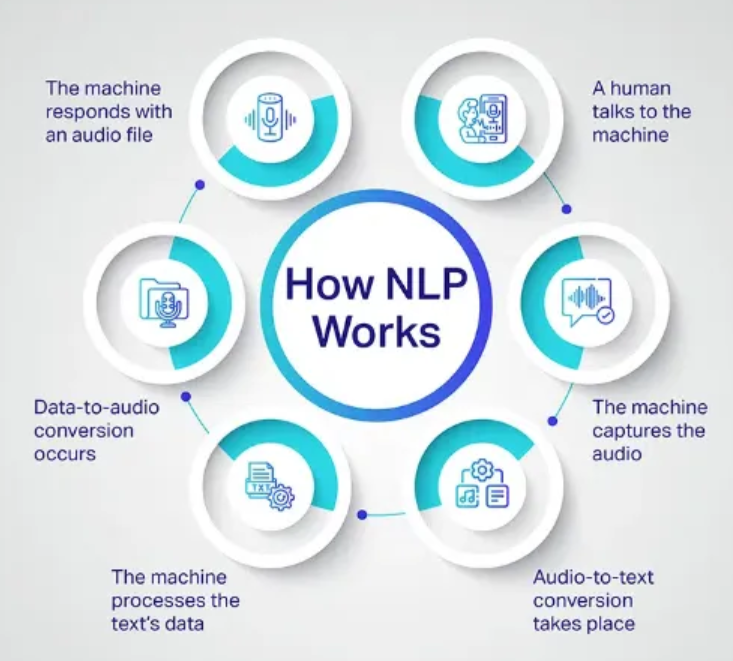
- The landscape of AI, especially in natural language processing (NLP), has seen remarkable advancements.
- Large language models (LLMs) from OpenAI, Google, and Microsoft have revolutionised human-computer interactions through generative AI.
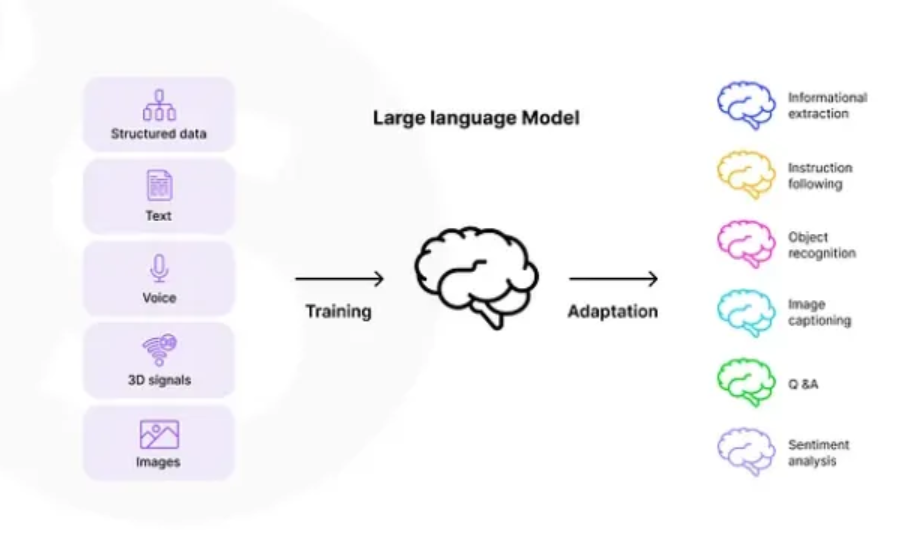
Problems with Current LLMs:
- High Energy Consumption: LLMs require significant computational power due to their large number of parameters. For instance, GPT-3 consumed 1,287 MWh of electricity for training, equivalent to an average household’s 120-year energy consumption.
- Pre-trained Nature and Hallucinations: LLMs generate contextually coherent but factually incorrect outputs, due to the limitations of their pre-training.
- Syntactic Issues: While LLMs excel in semantic understanding, they struggle with syntax, misinterpreting cues essential for generating accurate text.
Syntactics and Semantics with Quantum NLP:
- Quantum Computing: Quantum computing leverages phenomena like superposition and entanglement to reduce energy costs and enhance efficiency.
- Quantum Natural Language Processing (QNLP): QNLP addresses the limitations of current LLMs by integrating syntax and semantics more effectively, lowering hallucinations, and improving context comprehension.
- Improved Language Understanding: QNLP offers a deeper understanding of language by better mapping grammar rules with quantum phenomena.
Time-Series Forecasting:
- Quantum Generative Model (QGen): Quantum computing can handle time-series data, using fewer parameters than classical models.
- Advantages of QGen: It is effective for both stationary (stable) and nonstationary (fluctuating) data, offering more efficient pattern detection and anomaly identification.
- Recent Research: A Japanese study demonstrated that a QGen AI model outperforms classical methods in financial problem-solving with fewer computational resources.
Conclusion:
- Quantum computing, particularly QNLP and QGen, holds significant potential to overcome current LLM challenges, enabling more sustainable, efficient, and powerful AI applications.
| Practice Question: How can quantum computing address the limitations of large language models (LLMs) in terms of energy efficiency and accuracy? (150 Words /10 marks) |
3. How do emergency provisions impact Centre-State relations?
(Source – The Hindu, International Edition – Page No. – 10)
| Topic: GS2 – Indian Polity |
| Context |
|
Federal Structure of India:
- India follows a federal system with distinct governments at the Centre and in the States.
- The Seventh Schedule of the Constitution distributes powers between the Union and States, with law and order being the State’s responsibility.
Emergency Provisions:
- Part XVIII of the Constitution outlines emergency provisions, with Articles 355 and 356 focusing on the Centre’s duty towards States.
- Article 355 mandates the Centre to protect States from external aggression and internal disturbances and ensure State governments function according to the Constitution.
- Article 356 allows for the imposition of President’s rule when a State government cannot operate constitutionally.
Purpose of Article 355:
- Dr. B.R. Ambedkar incorporated Article 355 to justify the Centre’s intervention under Article 356 only in cases of constitutional obligation, preventing arbitrary use of power.
Judicial Interpretation:
- Article 356 was often misused to dismiss State governments until the Supreme Court’s S.R. Bommai case (1994), which restricted its use to situations where there is a breakdown of constitutional machinery, not merely a law and order issue.
- Article 356 is subject to judicial review and should not be used for political reasons.
- The Supreme Court has broadened the scope of Article 355 in various rulings to permit all actions necessary to protect States and ensure constitutional governance.
Commissions’ Recommendations:
- The Sarkaria Commission (1987), National Commission to Review the Constitution (2002), and Punchhi Commission (2010) recommended using Article 356 as a last resort, emphasizing the Centre’s duty under Article 355.
Manipur Crisis:
- The ongoing violence in Manipur represents a serious constitutional and law-and-order crisis.
- While political considerations may prevent the invocation of Article 356, all actions under Article 355 must continue to restore peace.
| PYQ: Under what circumstances can the Financial Emergency be proclaimed by the President of India? What consequences follow when such a declaration remains in force? (150 words/10m) (UPSC CSE (M) GS-2 2018) |
| Practice Question: Discuss the constitutional framework of emergency provisions in India, focusing on the use of Articles 355 and 356 in the context of maintaining law and order in states like Manipur. (150 Words /10 marks) |
4. What is the current status of the introduction of African cheetahs?
(Source – The Hindu, International Edition – Page No. – 11)
| Topic: GS3 – Environment – Conservation – Importance Species |
| Context |
|

Project Cheetah Overview
- Cheetah Action Plan (CAP): India’s initiative to introduce African cheetahs into its ecosystems, aiming to conserve the species and restore savanna habitats. It also supports future collaboration with Iran on Asiatic cheetah conservation.
- Project Management And Stakeholders: The NTCA, MoEFCC, Wildlife Institute of India, and Madhya Pradesh Forest Department oversee the project, with guidance from an expert committee.
- Eco-tourism: Cheetahs are intended to be a flagship species, promoting the restoration of dry-open forest ecosystems and benefiting local communities through eco-tourism.
Challenges of Long-Term Captivity
- Extended Captivity: The 12 surviving adult cheetahs have spent most of their time in captivity, contradicting the plan’s objective to release them into the wild. Prolonged captivity renders cheetahs unfit for release.
- International Standards: Namibian policy limits captivity for wild carnivores to three months, after which they are either euthanized or held permanently.
Cheetah Deaths
- Mortality Issues: Several cheetahs have died due to pre-existing conditions, poor management, or environmental factors like heatstroke. There are concerns about their suitability for survival in the Indian climate.
Location and Habitat
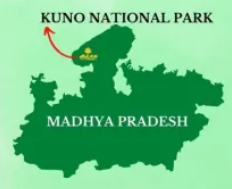
- Kuno National Park: Chosen as the most suitable site for cheetahs, although the animals have largely been held in captivity. Plans to release cheetahs in Gandhi Sagar Wildlife Sanctuary and Banni grasslands are delayed.
- Habitat Concerns: Doubts remain about the availability of sufficient high-quality habitat (4,000-8,000 sq. km) needed to sustain a viable cheetah population.
Measurable Outcomes
- Short-term Goals: Cheetah survival, home range establishment, reproduction, and eco-tourism have not been met due to extended captivity.
- Long-term Goals: Establishing a stable metapopulation and improving local economies through conservation efforts are the project’s ultimate aims, with a timeline extending up to 40 years.
| Practice Question: Discuss the objectives and challenges of the Cheetah Action Plan (CAP) initiated by India. How do the issues of captivity and habitat affect the long-term success of the project? (150 Words /10 marks) |
5. India Strongly Rejects Iran’s Supreme Leader’s Remarks on Muslim Suffering, Calls Comments “Misinformed”
(Source: Indian Express; Section: Cover Page; Page: 01)
| Topic: GS2 – International Relations |
| Context: |
| The article addresses Iran’s Supreme Leader Khamenei’s criticism of India’s treatment of Muslims, sparking a strong rebuttal from India, which deemed the remarks as misinformed and unacceptable. |
Analysis of News:
Iran’s Comments on India and Muslim Suffering
- Iran’s Supreme Leader, Sayyid Ali Hosseini Khamenei, recently included India among places where Muslims are suffering, along with Gaza and Myanmar.
- In a social media post, Khamenei emphasized the shared identity of the Islamic Ummah and highlighted the importance of supporting oppressed Muslims globally.
- This statement drew a sharp reaction from India, which labeled the comments as “misinformed” and “unacceptable,” urging Iran to reflect on its own record before commenting on other nations.
India’s Response and Historical Context
- India’s Ministry of External Affairs swiftly responded to Khamenei’s remarks with a strongly worded statement.
- The comments were dismissed as inaccurate, and India urged Iran to avoid making observations about other nations’ treatment of minorities without considering their domestic situations.
- This exchange comes against the backdrop of the second anniversary of Mahsa Amini’s death in Iran, which led to widespread protests against Iran’s treatment of women.
Iran’s Previous Criticisms of India
- Khamenei has previously commented on the plight of Muslims in India, particularly during moments of communal violence.
- Notably, he criticized the 2020 Delhi riots as a “massacre of Muslims” and urged India to address “extremist Hindus.”
- He also raised concerns about Kashmir following the revocation of Article 370 in 2019, calling for a just policy towards Kashmir’s Muslim population.
- Iran has a history of criticizing India during significant events such as the 2002 Gujarat riots and the 1992 Babri Masjid demolition.
Focus on Kashmir and Broader Iranian Concerns
- Khamenei’s rhetoric often centers on the situation in Kashmir, positioning it alongside other global Muslim issues such as Gaza and Afghanistan. His 2019 and earlier statements show a consistent concern for the rights of Kashmir’s Muslim population.
- Historically, Iran’s heightened focus on Kashmir aligns with periods of strained relations, such as during the India-U.S. civil nuclear deal, when India voted against Iran in international forums like the IAEA.
Conclusion
- Khamenei’s comments have revived a recurring theme in Iran’s foreign policy, emphasizing support for oppressed Muslims.
- However, India’s firm rejection of these remarks underscores the ongoing diplomatic tension between the two countries regarding sensitive communal and regional issues, particularly Kashmir.
| Issues in India-Iran relations |
|
| Practice Question: Discuss the diplomatic implications of Iran’s criticism of India’s treatment of Muslims, particularly in the context of Kashmir and communal violence. How should India navigate such external criticisms while maintaining its domestic and international relations? (250 words/15 m) |
PRELIMS FACTS
1. Rising Threat of Antimicrobial Resistance: A Major Challenge in India’s Fight Against Infections
(Source: Indian Express; Section: Express Network; Page: 13)
| Context: |
| The article highlights the growing threat of antimicrobial resistance (AMR) in India, exacerbating infections and sepsis deaths, and emphasizes the urgent need for better antibiotic use and diagnostic infrastructure. |
Analysis of News:
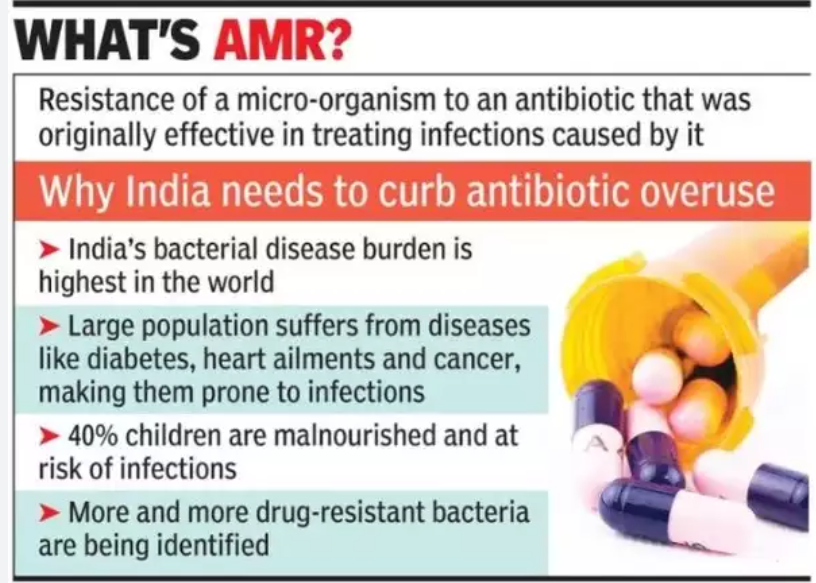

Case Overview
- A 60-year-old leukemia patient was admitted to the emergency department with high fever and low blood pressure.
- Despite starting broad-spectrum antibiotics, the drugs failed to work due to the development of a drug-resistant Klebsiella infection.
- This condition was eventually controlled using a combination of drugs.
Antimicrobial Resistance (AMR) Impact
- The patient’s deteriorating condition highlights antimicrobial resistance (AMR), where bacteria become resistant to previously effective medications. This is a growing concern in India and globally.
AMR and Sepsis in India
- Lancet Study Findings: In 2019, 60% of 29.9 lakh sepsis deaths in India were caused by bacterial infections. 10 lakh of these deaths were linked to AMR.
- Sepsis: A condition where the immune system reacts dangerously to bacterial infection, often leading to organ failure if untreated.
- Key AMR Statistics: 2.9 lakh sepsis deaths were directly attributable to AMR.
Causes and Challenges of AMR
Overuse and Misuse of Antibiotics:
- Many patients do not follow the prescribed dosage or discontinue treatment prematurely.
- Antibiotics are often used without proper diagnosis.
Limited Diagnostic Infrastructure:
- Inadequate local diagnostics lead to broad-spectrum antibiotic use.
- Rational antibiotic use requires better lab facilities for identifying specific bacteria and guiding treatment decisions.
Poor Sanitation:
- Infections spread due to inadequate sanitation, increasing demand for antibiotics and worsening resistance.
Global AMR Outlook
- The Global Research on Antimicrobial Resistance (GRAM) project forecasts over 39 million deaths globally due to antibiotic-resistant infections over the next 25 years.
Key Resistant Pathogens in India
- E. coli: Causes gut infections.
- Klebsiella pneumoniae: Causes pneumonia and urinary tract infections.
- Acinetobacter baumannii: Associated with hospital-acquired infections.
AMR in Children
- High Child Mortality: In 2019, 3.25 lakh children under five died from bacterial infections, with streptococcus pneumoniae being the deadliest.
2. Pregnancy Reshapes the Brain: Study Reveals Significant Changes in Grey and White Matter
(Source: Indian Express; Section: Explained; Page: 14)
| Context: |
| Pregnancy induces significant changes in a woman’s brain, alongside well-known hormonal and physical transformations. |
Analysis of News:
Study Findings
- Researchers mapped brain changes from three weeks before conception through nine months of pregnancy and two years postpartum.
Key Brain Changes
Grey Matter Reduction:
- A 4% decrease in the volume of cortical grey matter, which is the outermost layer of the brain responsible for processing information.
White Matter Increase:
- A 10% increase in the microstructural integrity of white matter, which consists of long fibers (axons) that connect different brain regions.
Hormonal Influence
- These changes coincide with rising levels of estradiol and progesterone, key hormones during pregnancy.
3. Government Plans ₹6,000 Crore Boost for Precision Farming with AI, Drones, and IoT Integration
(Source: Indian Express; Section: Express network; Page: 09)
| Context: |
| The Indian government is considering a ₹6,000 crore initiative to promote precision farming, leveraging modern technology like AI, IoT, drones, and data analytics to enhance agricultural productivity while minimizing environmental impact. |
Analysis of News:
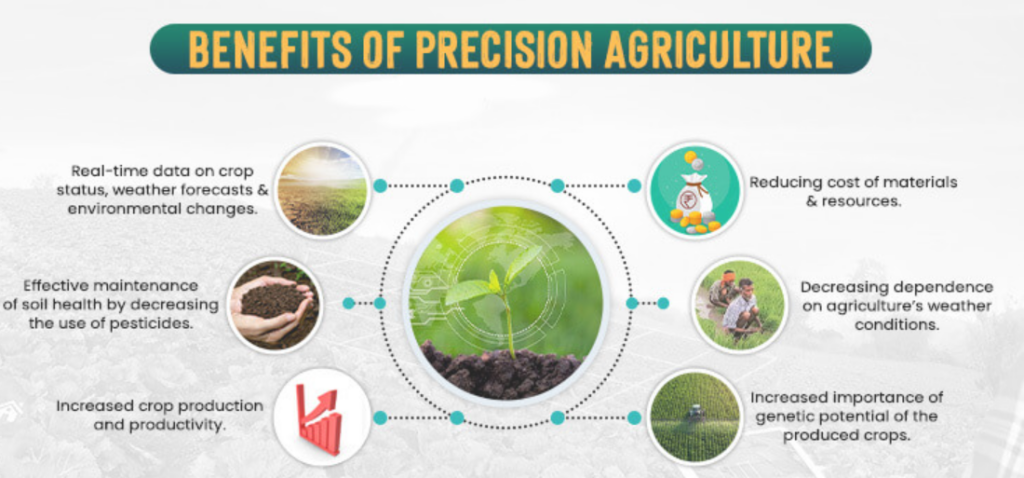
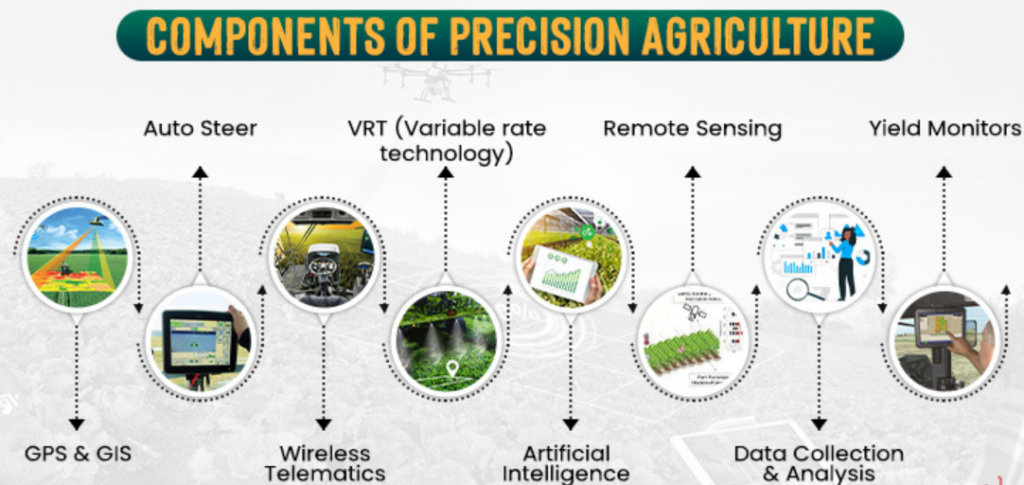
What is Precision Farming?
- Precision farming is an approach where inputs are utilised in precise amounts to get increased average yields, compared to traditional cultivation techniques. It is the science of improving crop yields using high technology sensor and analysis tools.
- Precision Farming utilizes multitude of advanced technologies and tools to monitor several parameters and collect information related to crop growth (like soil moisture, pH etc.). The information is used for targeted interventions.
- It is referred to as ‘precision’ because it is focused on performing the right intervention (e.g., providing water to crops), in the right place, at the right time, responding to the specific demands of individual crops and individual areas of land with superior levels of precision.
Smart Precision Horticulture Programme
- The Union Ministry of Agriculture plans to launch a Smart Precision Horticulture Programme under the existing Mission for Integrated Development of Horticulture (MIDH) scheme.
- Covering 15,000 acres from 2024-25 to 2028-29, the program is expected to benefit approximately 60,000 farmers.
Agriculture Infrastructure Fund (AIF)
- The Agriculture Infrastructure Fund (AIF) supports smart and precision agriculture with financial assistance.
- Farmers and farmer communities are eligible for loans with a 3% interest subvention for automation, drone usage, sensors, blockchain, AI, and IoT applications in farming.
International Collaboration
- The Centre is exploring partnerships with Israel and the Netherlands, where tech-driven farming solutions are advanced, through Centres of Excellence (CoEs).
- 100 CoEs are expected to be established in the next five years, with 32 Indo-Israel CoEs already in place across 14 states.
Precision Farming Development Centres (PFDCs)
- The government has established 22 PFDCs across various universities and research institutes to adapt modern technologies for local agricultural needs.
- These PFDCs are located in key states like Tamil Nadu, Karnataka, UP, Punjab, and others.
Technological Integration in Agriculture
- The Centre also releases funds for projects involving AI, machine learning, and other tech under schemes like the National e-Governance Plan in Agriculture.
4. Union Finance Minister Smt. Nirmala Sitharaman to launch NPS Vatsalya Scheme on September 18, 2024
(Source – https://pib.gov.in/PressReleseDetail.aspx?PRID=2055393 )
| Context |
|
The NPS Vatsalya scheme:
Key Features:
- Allows parents to open a pension account for their children.
- Flexible contributions starting from Rs. 1,000 annually.
- Investment options designed for families from various economic backgrounds.
- Permanent Retirement Account Number (PRAN) cards will be issued to new minor subscribers.
Objectives:
- Promotes early financial planning for children’s future.
- Encourages long-term wealth accumulation through compounding.
- Aims to enhance financial security and independence for future generations.
Administration:
- Managed by the Pension Fund Regulatory and Development Authority (PFRDA).
- An online platform will be launched for easy subscription and management.
Significance:
- Marks a significant step in India’s pension system by ensuring early financial security.
Demonstrates the Government of India’s commitment to promoting financial planning from a young age
5. After peace talks, Dalits get entry to temple in Tamil Nadu
(Source – The Hindu, International Edition – Page No. – 1)
| Context |
|
Arulmigu Pidari Ettiamman Temple and Dalit Entry:
- Location: Gummidipoondi taluk, Tiruvallur district, Tamil Nadu.
- Deity: Dedicated to Goddess Ettiamman, a revered local deity.
- Recently, Dalits were denied entry after a kumbhabhishekam ceremony by dominant caste Hindus, sparking a controversy.
- The District Collector intervened, reopening the temple for all communities, emphasising that the temple land belongs to the public.
- Police personnel and staff from the Hindu Religious and Charitable Endowments (HR&CE) department were stationed to ensure equal access,.
- The reopening of the Arulmigu Pidari Ettiamman Temple symbolises the ongoing struggle against caste-based discrimination in religious spaces.
6. Stone-eaters that threaten Iran’s ancient Persepolis
(Source – The Hindu, International Edition – Page No. – 4)
| Context |
|
Persepolis Conservation Battle:
- Conservationists at Persepolis, Iran’s ancient site, are battling lichens eroding its monuments.
- Persepolis, built in the 6th century BC by Darius I, has faced destruction, looting, and harsh weather.
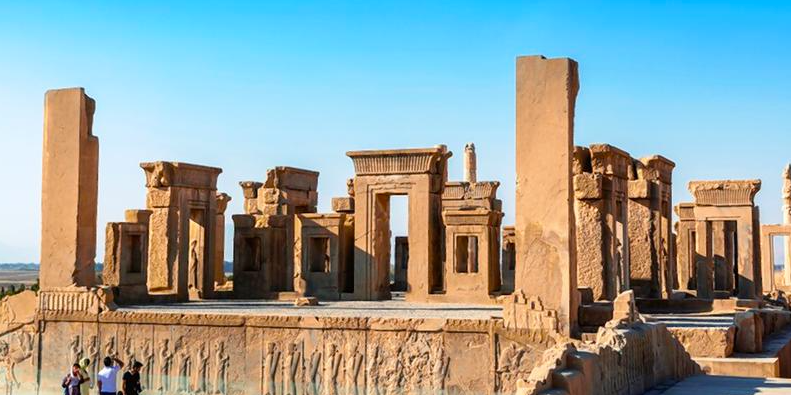
- It became a UNESCO World Heritage Site in 1979.
- Lichens, which grow on stone surfaces, threaten intricate carvings and sculptures.
- Industrialisation, acid rain, and desert climate exacerbate the problem.
- Lichens dissolve minerals, causing long-term damage.
- Many of Persepolis’s carvings are already lost or severely affected by lichens.





